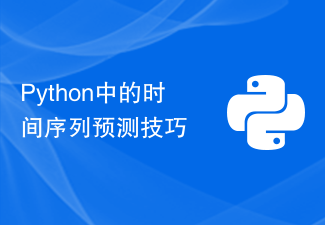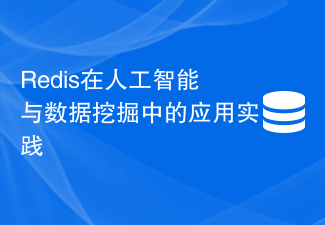The basic steps of data mining are: 1. Define the problem; 2. Establish a data mining library; 3. Analyze the data; 4. Prepare the data; 5. Build the model; 6. Evaluate the model; 7. Implement.

#The operating environment of this article: windows10 system, thinkpad t480 computer.
The specific steps are as follows:
1. Define the problem
The first and most important requirement before starting knowledge discovery is to understand the data and business problems. You must have a clear and clear definition of your goals, that is, decide what you want to do. For example, when you want to improve the utilization rate of your email, you may want to "increase user utilization rate" or you may want to "increase the value of one user use." The models established to solve these two problems are almost completely different. , a decision must be made.
2. Establishing a data mining library
Establishing a data mining library includes the following steps: data collection, data description, selection, data quality assessment and data cleaning, merging and integration, and building metadata , load the data mining library, and maintain the data mining library.
3. Analyze data
The purpose of analysis is to find the data fields that have the greatest impact on the prediction output and decide whether to define export fields. If the data set contains hundreds or thousands of fields, then browsing and analyzing the data will be a very time-consuming and tiring task. In this case, you need to choose a tool software with a good interface and powerful functions to assist you in completing these tasks. .
4. Prepare data
This is the last step of data preparation before building the model. This step can be divided into four parts: selecting variables, selecting records, creating new variables, and converting variables.
5. Building a model
Building a model is an iterative process. Different models need to be carefully examined to determine which model is most useful for the business problem faced. First use a portion of the data to build a model, and then use the remaining data to test and validate the resulting model. Sometimes there is a third data set, called the validation set, because the test set may be affected by the characteristics of the model, and an independent data set is needed to verify the accuracy of the model. Training and testing data mining models requires splitting the data into at least two parts, one for model training and the other for model testing.
6. Evaluation model
After the model is established, it is necessary to evaluate the results obtained and explain the value of the model. The accuracy obtained from the test set is only meaningful for the data used to build the model. In practical applications, it is necessary to further understand the types of errors and the related costs caused by them. Experience has proven that a valid model is not necessarily a correct model. The direct reason for this is the various assumptions implicit in model building, so it is important to test the model directly in the real world. Apply it to a small area first, obtain test data, and then promote it to a large area after you feel satisfied.
7. Implementation
After the model is established and verified, there are two main ways to use it. The first is to provide analysts with a reference; the other is to apply this model to different data sets.
Free learning video sharing: Introduction to programming
The above is the detailed content of What are the basic steps of data mining. For more information, please follow other related articles on the PHP Chinese website!
 MySql的数据分析:如何处理数据挖掘和统计Jun 16, 2023 am 11:43 AM
MySql的数据分析:如何处理数据挖掘和统计Jun 16, 2023 am 11:43 AMMySql是一款流行的关系型数据库管理系统,广泛应用于企业和个人的数据存储和管理中。除了存储和查询数据外,MySql还提供了一些功能,如数据分析、数据挖掘和统计,可以帮助用户更好地理解和利用数据。数据在任何企业或组织中都是宝贵的资产,通过数据分析可以帮助企业做出正确的业务决策。MySql可以通过多种方式进行数据分析和数据挖掘,以下是一些实用的技术和工具:使用
 如何使用 Go 语言进行数据挖掘?Jun 10, 2023 am 08:39 AM
如何使用 Go 语言进行数据挖掘?Jun 10, 2023 am 08:39 AM随着大数据和数据挖掘的兴起,越来越多的编程语言开始支持数据挖掘的功能。Go语言作为一种快速、安全、高效的编程语言,也可以用于数据挖掘。那么,如何使用Go语言进行数据挖掘呢?以下是一些重要的步骤和技术。数据获取首先,你需要获取数据。这可以通过各种途径实现,比如爬取网页上的信息、使用API获取数据、从数据库中读取数据等等。Go语言自带了丰富的HTTP
 数据挖掘和数据分析的区别是什么?Dec 07, 2020 pm 03:16 PM
数据挖掘和数据分析的区别是什么?Dec 07, 2020 pm 03:16 PM区别:1、“数据分析”得出的结论是人的智力活动结果,而“数据挖掘”得出的结论是机器从学习集【或训练集、样本集】发现的知识规则;2、“数据分析”不能建立数学模型,需要人工建模,而“数据挖掘”直接完成了数学建模。
 火山引擎工具技术分享:用 AI 完成数据挖掘,零门槛完成 SQL 撰写May 18, 2023 pm 08:19 PM
火山引擎工具技术分享:用 AI 完成数据挖掘,零门槛完成 SQL 撰写May 18, 2023 pm 08:19 PM在使用BI工具的时候,经常遇到的问题是:“不会SQL怎么生产加工数据、不会算法可不可以做挖掘分析?”而专业算法团队在做数据挖掘时,数据分析及可视化也会呈现相对割裂的现象。流程化完成算法建模和数据分析工作,也是一个提效的好办法。同时,对于专业数仓团队来说,相同主题的数据内容面临“重复建设,使用和管理时相对分散”的问题——究竟有没有办法在一个任务里同时生产,同主题不同内容的数据集?生产的数据集可不可以作为输入重新参与数据建设?1.DataWind可视化建模能力来了由火山引擎推出的BI平台Da
 Python中的时间序列预测技巧Jun 10, 2023 am 08:10 AM
Python中的时间序列预测技巧Jun 10, 2023 am 08:10 AM随着数据时代的到来,越来越多的数据被收集并用于分析和预测。时间序列数据是一种常见的数据类型,它包含了基于时间的一连串数据。用于预测这类数据的方法被称为时间序列预测技术。Python是一种十分流行的编程语言,拥有强大的数据科学和机器学习支持,因此它也是一种非常适合进行时间序列预测的工具。本文将介绍Python中一些常用的时间序列预测技巧,并提供一些在实际项目中
 Redis在人工智能与数据挖掘中的应用实践Jun 20, 2023 pm 07:10 PM
Redis在人工智能与数据挖掘中的应用实践Jun 20, 2023 pm 07:10 PM随着人工智能和大数据技术的兴起,越来越多的公司和业务开始关注如何对数据进行高效的存储和处理。Redis作为一种高性能的分布式内存数据库,越来越受到人工智能和数据挖掘领域的关注。本文将从Redis的特点及其在人工智能和数据挖掘应用中的实践做一个简单介绍。Redis是一种开源、高性能、可扩展的NoSQL数据库。它支持多种数据结构、提供用于缓存、消息队列和计数器等
 如何在Python中使用关联规则进行数据挖掘?Jun 04, 2023 am 09:02 AM
如何在Python中使用关联规则进行数据挖掘?Jun 04, 2023 am 09:02 AMPython是一种功能强大的编程语言,可以应用于各种数据挖掘任务。关联规则是其中一种常见的数据挖掘技术,它旨在发现不同数据点之间的关联关系,以便更好地理解数据集。在本文中,我们将讨论如何使用Python中的关联规则进行数据挖掘。什么是关联规则关联规则是一种数据挖掘技术,用于发现不同数据点之间的关联关系。它通常用于购物篮分析,其中我们可以发现哪些商品经常一起购
 PHP中如何进行自动文本分类和数据挖掘?May 22, 2023 pm 02:31 PM
PHP中如何进行自动文本分类和数据挖掘?May 22, 2023 pm 02:31 PMPHP是一种优秀的服务器端脚本语言,广泛应用于网站开发和数据处理等领域。随着互联网的快速发展,数据量的不断增加,如何高效地进行自动文本分类和数据挖掘成为了一个重要的问题。本文将介绍在PHP中进行自动文本分类和数据挖掘的方法和技巧。一、什么是自动文本分类和数据挖掘?自动文本分类是指根据文本内容自动将文本进行分类的过程,通常使用机器学习算法进行实现。数据挖掘是指

Hot AI Tools

Undresser.AI Undress
AI-powered app for creating realistic nude photos

AI Clothes Remover
Online AI tool for removing clothes from photos.

Undress AI Tool
Undress images for free

Clothoff.io
AI clothes remover

AI Hentai Generator
Generate AI Hentai for free.

Hot Article

Hot Tools

SublimeText3 Linux new version
SublimeText3 Linux latest version

Notepad++7.3.1
Easy-to-use and free code editor

Atom editor mac version download
The most popular open source editor

WebStorm Mac version
Useful JavaScript development tools

ZendStudio 13.5.1 Mac
Powerful PHP integrated development environment






